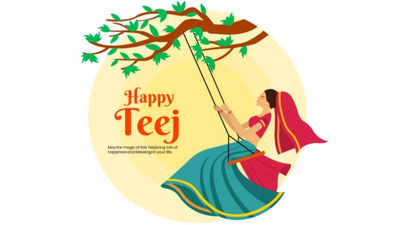Teej is a vibrant festival celebrated across various regions of India, including major states like Uttar Pradesh, Rajasthan, Bihar, and Madhya Pradesh. It’s a time of great joy and festivity when women come together to observe special traditions and rituals. The Teej festivals are centered around fasting, worshipping Lord Shiva and Goddess Parvati- the eternal symbols of love and devotion- and enjoying melodious traditional songs and dances.
It celebrates the sacred theme of marital happiness and the arrival of the monsoon season, reflecting the rich cultural traditions of the regions where they are observed. Interestingly, Teej includes three distinct festivals, each with its own significance. Read on to know more about them here.

All about Kajari Teej Also known as Badi Teej, Kajalia Teej, or Satudi Teej, Kajari Teej is celebrated by married women in states like Uttar Pradesh, Bihar, Rajasthan, Madhya Pradesh, and even parts of Haryana and Jharkhand. The festival is marked by fasting and praying for the well-being of husbands and the prosperity of the family. In 2024, Kajari Teej will be celebrated on August 22, with beautiful rituals, deep devotion, and cultural festivities.
The Tritiya Tithi begins at 5:06 PM on August 21 and ends at 1:46 PM on August 22. The celebration will take place on August 22, which aligns with the most auspicious time, known as Udaya Tithi. Origin and significance of Kajari Teej Kajari Teej holds immense cultural and spiritual importance, especially for married women.
This festival celebrates marital harmony, the well-being of the family, and the prosperity of the household. The significance of Kajari Teej goes back to the divine love story of Goddess Parvati and Lord Shiva. According to Hindu mythology, Goddess Parvati undertook intense penance and spiritual practices to win Lord Shiva's love.
Her unwavering devotion eventually led to their sacred union, symbolizing the celebration of love and commitment. Kajari Teej honours this divine love and the sanctity of marriage. Women fast and perform rituals inspired by Goddess Parvati’s devotion, seeking blessings for their husbands' longevity and the welfare of their families.
Beyond the marital aspect, the festival emphasises the overall prosperity and happiness of the household. For unmarried women: Kajari Teej is also considered highly auspicious for unmarried women. Observing the festival is believed to bring blessings in finding a suitable life partner.
It offers a spiritual opportunity to seek divine intervention for resolving marriage-related challenges and attracting a compatible spouse. Celebrations, rituals and traditions of Kajari Teej The auspicious day of Kajari Teej begins early, with women waking up before sunrise to prepare for the day’s rituals and start their fast. Homes are thoroughly cleaned and beautifully decorated with vibrant rangolis, fresh fragrant flowers, and lights.
Women dress in traditional, beautifully crafted regional clothes. Special pujas are performed, dedicated to Goddess Parvati, who symbolizes marital harmony and devotion, and Lord Shiva. Offerings include fresh, juicy fruits, specially prepared sweets, and flowers, accompanied by the chanting of melodious prayers.
A significant ritual unique to Kajari Teej involves making a small pond in front of the house from clay and cow dung. This pond is filled with raw milk and water, and a lamp is placed at its edge. Offerings of water, roli, and moli are made to Neemdi Mata.
Married women pray for their husband's long life, while unmarried women fast without water, seeking blessings for a good husband. This tradition combines special offerings with deep devotion and prayers. Women gather in groups at temples or in their communities to engage in singing traditional folk songs, sharing stories related to the festival, and performing dances, all in celebration of the spirit of Kajari Teej.
Traditional aromatic foods and sweets are prepared and shared among family and community members as part of the festivities. A special ritual of Kajari Teej involves applying kajal to the eyes of children in the family, which is believed to protect them from evil and bring good fortune. How is Kajari Teej different from other types of Teej? There are two more types of Teej festivals celebrated in Hinduism, apart from Kajari Tej.
They are: Hariyali Teej, and Hartalika Teej. Let’s explore insights about them here: Hariyali Teej Hariyali Teej is a significant festival celebrated with great joy across North India, including in states like Rajasthan and Uttar Pradesh. Observed during the Shravana month on Shukla Paksha Tritiya, the festival revolves around women dressing in green, symbolizing prosperity, and enjoying beautiful ‘Jhoolas’ decorated with fresh vibrant flowers while singing traditional songs.
A unique ritual of Hariyali Teej is the tradition of Sindhara. Sindhara is a special gift package sent by the parents of a married woman to her and her parents which includes sweets, bangles, and henna, fostering family ties. Women pray to Lord Shiva and Goddess Parvati for their husbands' well-being and take part in fasting and temple visits.
The festival also celebrates the greenery of the monsoon season and the divine union of the deities. Hartalika Teej Hartalika Teej is another highly auspicious Hindu festival that celebrates the story of Goddess Parvati, who was abducted by a friend to secure her marriage to Lord Shiva. The name "Hartalika" means "abduction" and "female acquaintance.
" To celebrate this uniquely sacred event, women receive gifts like clothes and jewellery, decorate their hands with mehendi, and wear traditional green and red attire. They observe a fast, often staying up all night singing, and conclude the celebration with Teej Puja the next morning. And so, all Teej festivals are considered highly auspicious and meaningful, each with its own special traditions and significance.
They celebrate different aspects of devotion, nature, and seasons, showing the rich cultural and religious practices of the regions..



















